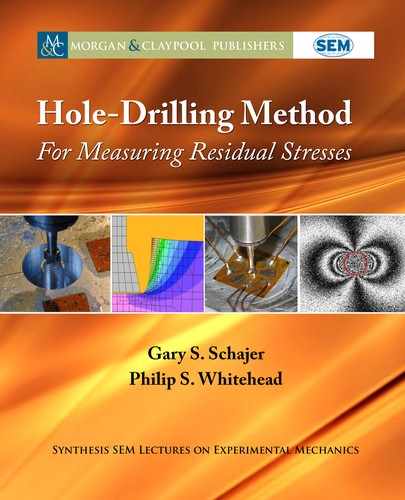2.7. RING-CORE METHOD 29
output stress results. While the effect is seen in the mathematics, the behavior has physical
origins. It occurs because of the indirect relationship between strain and stress that occurs
due to their spatial separation. is is a St.Venant type effect, which gets worse as the sep-
aration between the strain and stress locations increase. us, for the Slitting Method, for
example, the ability to identify interior stresses from a top-surface strain gauge measure-
ment rapidly diminishes with increasing stress distance from the strain gauge. Over the
years some sophisticated mathematical methods have been developed to stabilize the stress
solutions in the presence of strain measurement noise. ese are effective, but they cannot
circumvent the underlying physics and they cannot give solutions for interior stresses at
remote cut depths beyond the point where those stresses no longer make any significant
contribution to the measured strains. In addition, the mathematical methods can only re-
duce sensitivity to measurement noise, not eliminate it. us, a scrupulous experimental
procedure remains essential to minimize the presence of noise in the original measured
data.
2.7 RING-CORE METHOD
e Ring-Core Method is in concept a 2-D extension of the Two-Groove and Slitting Meth-
ods. e latter two methods are both single-direction methods that measure the normal stress
perpendicular to the slots or slit. is characteristic requires that the direction of the most sig-
nificant normal stress be known in advance so that the cut direction can be chosen appropri-
ately. In-plane shear stress could also be evaluated by using an additional 45
ı
strain measure-
ment, although this is rarely done in practice. For the general 2-D case the Ring-Core Method,
schematically illustrated in Figure 2.6, is used. Here, the slots of the Two-Groove Method are
adapted into a single circular slot that isolates the enclosed island of material in much the same
way as the Two-Groove Method, but from all in-plane directions. us, it is not necessary to
know or guess in advance the desired measurement direction. e single strain gauge of the
Two-Groove Method is replaced by a three-element rosette to provide sufficient data to eval-
uate the two in-plane normal stresses and the in-plane shear stress. e Ring-Core Method is
quite widely used and several specialized strain gauge rosettes and annular milling devices are
available commercially.
e Ring-Core Method can be used in two different ways. In the first way, the method
is equivalent to a 2-D version of the Two-Groove Method. Strain readings are taken before
and after ring cutting in one step to a depth sufficient to relieve the surface residual stresses
completely. e three in-plane stress components can then be evaluated from the measured
strain changes by direct application of Hooke’s Law. is type of measurement requires ring
cutting to a depth approximately equal to the ring diameter, commonly 20 mm but could be
greatly smaller or larger. is type of measurement is suited to the case where the residual stresses
are known to be generally uniform with depth from the measured surface. e evaluated stresses
are average values, weighted in favor of the near-surface stresses.
..................Content has been hidden....................
You can't read the all page of ebook, please click here login for view all page.
